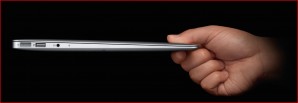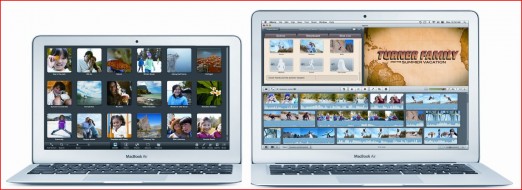New MacBook Air reinvigorates Apple’s lineup with features and pricing that move Air from niche to mainstream. A new version of OS X is a few months away.

Apple today unveiled two new models of MacBook Air, the sleek and thin notebook computers that were until today priced for a niche market. The two new models, now available, redefine the notebook market with pricing and features that move the line into the mainstream.
The announcement was part of a press conference led by Apple CEO Steve Jobs called “Back to the Mac” which also introduced a new version of iLife and the next version of OS X, code name Lion. The newest version of OS X borrows significantly from Apple’s recent work on iPad.
Mac is a $22 billion business for Apple. Ten years ago it was 90% of Apple revenue. Today is it less than 30%, as sales of iPhone and iPad have taken off. Today Apple claims it has a 20.7% share of the retail computer market.
There was much gossip before today’s announcement by Jobs and his lieutenants that the next Macs would offer touch-screen capabilities, similar to what is now available on the iPad and iPhone. But Jobs set all such talk to rest. Apple researchers came to the conclusion that “touch services don’t want to be vertical,” Jobs said, adding that touch-based input is “ergonomically terrible” as a vertical solution. So going forward gesture-based input popularized by iPhone and iPad will be placed on the Mac’s built-in trackpad and Magic Mouse (sold separately).

Never Too Thin or Too Light
Like the first generation of MacBook Air, the two new models are thin and light. The 11-inch model is 2.3 pounds (1.06kg), while the 13” model is 2.9 pounds (1.32kg). When closed, both are 0.68” (1.7cm) thick at the back and 0.11” (0.3cm) at the front.
The smaller Air features an 11.6” (diagonal) high-resolution LED backlight glossy with native resolution of 1366×768. The larger model sports a 13.3” screen with native resolution of 1440×900. Both are driven by an Nvidia GeForce 320M graphics processor with 256MB of DDR3 SDRAM, shared with main memory. Both are capable of dual display and video mirroring, with up to 2560×1600 possible on the external display. Apple claims graphics performance is over 2x faster when comparing the Nvidia GeForce 320M with the previous generation MacBook Air video controller, the Nvidia GeForce 9400M.
In addition to the thin, snazzy unibody design, what sets MacBook Air apart from the rest of the MacBook line (still being sold) is the lack of moving parts. No optical drive, no hard drives.
For storage the MacBook Air uses solid-state flash drives. If using a DVD or CD is necessary, MacBook Air offers DVD/CD Sharing, an operating system feature that allows the MacBook to wirelessly “borrow” the optical drive of a nearby PC or Mac. A USB-based SuperDrive is an optional accessory.
The new 13.3-inch model, with a 1.86GHz Core 2 Duo processor, will cost $1,299 with 128GB of flash storage; $1,599 for 256GB. The 11.6-inch model, which has a 1.4GHz processor, will cost $999 for a 64GB model and $1,199 for 128GB. At these prices, all models come standard with 2GB of 1066MHz DDR 3 memory, with 4GB maximum. We recommend an immediate upgrade to 4GB unless email is your most demanding application.
At one point during the press event Jobs showed an image of inside MacBook Air; the battery takes most of the available space. The 11” model is rated at 5 hours of unplugged wireless productivity; the 13” model is rated at 7 hours. Both models are rated for up to 30 days of standby time. The smaller MacBook Air draws 35 watts, the larger 50 watts.
The built-in camera comes with a bonus; the FaceTime video telephony utility so popular on iPhone 4 will ship with the new MacBook Air.

The Lion Roars in Harmony with iOS
In addition to introducing new MacBooks, Apple also gave a preview of the next version of the OS X operating system that powers the entire Mac line. Nicknamed Lion, it won’t ship until mid-2011. “Back to the Mac” describes the technology cycle providing inspiration to this next OS. As Jobs explained, at first OS X inspired thinking for the iPhone and iPad and the development of iOS (Apple’s mobile operating system); now iOS inspires the next iteration of OS X.
New features include:
- The Mac App Store, a new way to install and automatically update desktop apps
- Launchpad, new home for Mac apps
- System-wide support for full screen apps
- Mission Control, a navigation system which unifies the existing Exposé, Dashboard, and Spaces with the new Launchpad and full screen apps
As with the Apps Store for iPhone and iPad, Apple will take a 30% cut to offer paid apps to users. It will work through iTunes like the existing App Store. No word yet if professional creative applications like AutoCAD, Illustrator, Microsoft Office, or ArchiCAD are expected to be sold through the Mac App Store the same way as a $1.99 restaurant finder. The Mac App Store is one feature which won’t wait for the release of Lion; Apple expects Snow Leopard OS X users to have access to it within 90 days.
What We Think
The Apple Obsessives are lining up right now for a new MacBook Air, and that’s all fine and good. It’s sleek, fast, green, and it has a fat battery. The Rest of Us now have two more really excellent choices when buying a new notebook computer. Some of the best features come with the OS, so remember Apple isn’t releasing Lion for a few more months. Also remember, MacBook Air runs Windows if you provide the OS.
If you do buy a MacBook Air, don’t settle for the standard 2GB of RAM; upgrade to 4GB immediately. And buy the extended warranty—advice we offer for any notebook computer.





